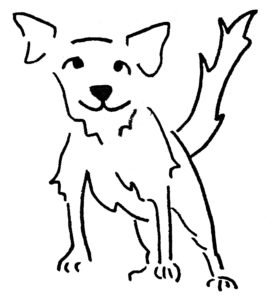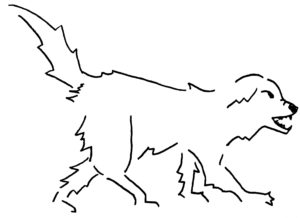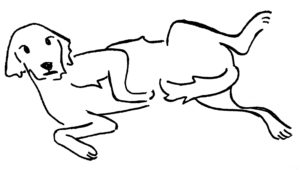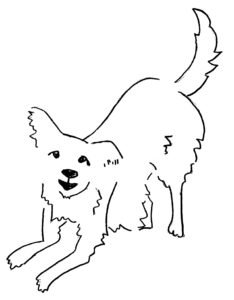Although we often talk to them, dogs don’t necessarily talk back to us, or do they? Yes, actually they do! Dogs do indeed express a wide range of emotions through a well-developed method of body language. They use their bodies to effectively communicate with each other and other animal species, humans included!
Using different sounds, facial expressions, eye and body movements, ear positioning, posture, fur and tail position (and sometimes even emitting smells!) dogs communicate very effectively with each other, and us too … maybe it is US that are just not understanding THEM sometimes?
Veterinarians and animal behaviorists learn the “language of dog” pretty quickly in order to find out what might be hurting our pups or causing them to be fearful. Sometimes we analyze dog body language to figure out what might be provoking certain behaviors that pet owners can’t quite figure out. Better yet, we use these clues to devise plans for what we can do to help our dogs live a confident, happy life with you–their favorite person.
The Benefits of Understanding Dog Language to Prevent Human Injury
It is extremely important for pet parents to try to get to know their dog’s body language accurately–not only to make their dog confident and comfortable, but also to protect any vulnerable humans that their dog may encounter. In this way, understanding dog body language is essential to creating a peaceful and harmonious mixed-species household!
The ability to detect when your dog is not feeling comfortable will also assist with early medical intervention in times of illness. For example, if your dog normally loves scratches on his back but you notice fearful behavior when you start petting that area, it may indicate they are experiencing pain.
By reading the body language of both your own dog and others you may encounter, you can also protect other humans and animals when a dog is showing signs of being nervous, fearful, or potentially aggressive. In this way, you can be a hero who helps avoid a confrontation!
While the brain and actions of a pup can still be perplexing at times, the following are some descriptions that pet parents can recognize to help decipher what your pup may be trying to say. After all, since we can’t educate dogs on how to speak OUR language, it is up to humans to learn how to speak theirs. While perusing these descriptions, you may realize that you actually do speak a little “dog” without even knowing it, as the years of bonding with your pup have already taught you a lot about their likes and dislikes!
Common Body Language of Dogs
Relaxed
Dogs that are feeling relaxed and approachable show that they are calm and happy about your presence through their body posture and expressions.
Head, Eyes, Ears: The head will be up with eyes, ears, and facial expressions all in a soft, natural, and relaxed position.
Facial Expressions, Mouth: The mouth will be open and the tongue exposed, almost like they are grinning at you!
Body Position and Tail: Their weight will be evenly distributed on all 4 paws (or comfortably laying down), with the tail wagging in a relaxed and natural position.
This dog is telling those around that they are not feeling threatened by anything at that moment. Still use caution if approaching this dog, especially if they are unfamiliar to you. Be on the lookout for changes in their facial expression and body position because even if they are not feeling threatened, changes in the surroundings could alter their mood.

Playful
Many of us easily recognize a dog that is feeling playful and ready to have a good time!
Head, Eyes, Ears: The ears are usually up or perked forward, with pupils dilated and eyes focusing on their potential playmate.
Facial Expressions, Mouth: The mouth is usually open, tongue out, and they may be egging you on with a toy in their mouth or at their feet.
Body Position and Tail: They may take a crouching position with their front end, and lower their chest to the ground with elbows bent, rear end in the air, and with the tail up and probably wagging.
This position may be followed by a run or leap as well as some playful barking. Excited jumping around indicates playfulness and his willingness to bring you into the fun!
Alert/Interested
A dog that is alert and interested in something, like a squirrel in the yard or some friends walking by on the sidewalk outside, will be laser focused with his body very still, sizing up the situation.
Head, Eyes, Ears: The head will be up and alert, ears pricking forward, eyes will be wide.
Facial Expressions, Mouth: The mouth will be closed, lips relaxed, and very still.
Body Position and Tail: They will be standing very straight and tall, sometimes leaning forward slightly, and the tail may be sticking out horizontally and gently wagging.
This dog is interested, focused, and assessing whether a threat is present, and if action needs to be taken, like bolting towards that squirrel if given the opportunity!

Dominant/Aggressive
This dog is perceiving a threat, like a postal worker “invading their territory” by approaching their front door. In response to the perceived threat, he shows that he is feeling aggressive, dominant, and confident in his position protecting the house.
Head, Eyes, Ears: The ears are forward and spread slightly, and pupils are dilated, eyes holding a firm stare at the “enemy.”
Facial Expressions, Mouth: The face may show wrinkles in the forehead and nose, with the lips curled, showing their teeth as potential weapons, sometimes with an open mouth. This dog may be growling and/or barking as a warning as well.
Body Position and Tail: The tail is raised, stiff, and bristled, the fur on his upper and lower back (“hackles”) are raised. Their body is stiff, and they are standing on all 4 legs evenly, leaning forward to express dominance and the willingness to move forward.
This dog is telling everyone that he will act aggressively if he feels his turf is being threatened. When dogs are in the dominant/aggressive state, they are highly stimulated and may attack or bite — not just their target, but anything closeby — when they are feeling this level of arousal. Use extreme caution around this dog and if you are noticing this unwanted behavior in your pup, check out our blog for what to do with an aggressive dog.

Fearful/Aggressive
When a dog is fearful of something, like a new visitor into the home, they may also respond with aggression in order to protect themselves against a perceived threat. This dog is not submitting to the threat, but instead sending a warning that they are scared but willing to defend themselves by responding to a conflict with a bite or aggressive behavior.
Head, Eyes, Ears: The head will be lower and bowed down a little, ears will be back, and pupils dilated and focused on the threat.
Facial Expressions, Mouth: The face will have wrinkles at the nose, and the lips may be curled showing some teeth. They may be growling a warning as well.
Body Position and Tail: They will face the individual that is the perceived threat, tuck their tail between their legs, and raise the hackles over their upper and lower back. Their body will be lowered and muscles tight and stiff.
Fearful dogs may also release their anal glands (small sacs that contain a fishy-smelling fluid, located under the skin on the left and right of the anus). This dog is feeling threatened and scared but also sending the message that he is willing to bite if he feels provoked, so use extreme caution if you see these signs.

Fearful/Stressed But Submissive
Some dogs that are fearful will actually not respond with aggression, and instead will offer signs of submission. They want to avoid conflict with individuals that they feel are threatening to them. Unfortunately, veterinarians tend to see this body language often, as dogs can be quite nervous during their exams — but we do our best to ease their fears with slow, gentle handling and lots of snacks!
Head, Eyes, Ears: The ears will be back, and eye contact will be brief and indirect with the dog choosing not to look at the source of the stress directly, in hopes to avoid confrontation. Often, you will notice the dog physically turns his head away from someone trying to interact with them–like a child–in hopes of avoiding a stressful situation.
Facial Expressions, Mouth: They may be panting, licking at the air, their lips, or the face of the threat (dog or human), and they may also yawn (dogs may yawn due to stress, not because they are tired!).
Body Position and Tail: They will tuck their tail down, and maybe slightly wag it, lower their body and cower. Their front paw may be raised, and their body may be slightly crouched and leaning back.
The fishy-smelling anal glands may be released here too, since they are nervous. A dog exhibiting this body position is feeling very anxious and uncomfortable. He is telling those around him that he is feeling nervous about his surroundings but not wanting to be aggressive.

Extreme Fear/Submission
Occasionally, you will meet a dog that is very submissive, meaning that they do not want to be perceived as a threat or aggressor in any way to a person or dog. As a person (even a well-loved pet parent) or dog approaches, they may possibly urinate a small puddle and this action is called “submissive urination”.
Head, Eyes, Ears: The eyes will be squinting, and ears back and flat.
Facial Expressions, Mouth: The mouth will stay closed.
Body Position and Tail: As they are approached, they will cower and then lay down and roll to their back with their head outstretched, exposing the stomach, chest and neck. They may tuck their tail between their legs.

It may look like they are inviting you in for a belly rub, but instead, these submissive dogs are indicating to the other animal that they willingly accept their low social status and are surrendering themselves in hopes of avoiding conflict and physical confrontation.
Sometimes some of the above fearful and aggressive messages can be followed by a bite or attack if the threat crosses over the threshold of that dog. Dogs rarely bite or attack unprovoked, and understanding the visible “warning signs” that dogs communicate can keep both dogs and humans safe. Children are especially vulnerable to altercations with dogs, as they want to snuggle every dog they see and often are oblivious to the warning signs that dogs are trying to communicate. That’s where YOU come in as the doggie translator!
If a dog is showing aggression toward humans, even if he is a young puppy, it is extremely important to seek the opinion of a veterinarian. By performing a physical exam and discussing the pup’s behavior with you, your veterinarian can identify any physical problems that may be contributing to the aggressive behavior. Ultimately, your veterinarian can assess if the behavior problems you are seeing in the home need the intervention of a canine mental health professional (board-certified veterinary behaviorist) or simply a reputable dog trainer.
What if the worst-case scenario happens, and a dog bites a person? Dog bites should be followed up with appropriate medical attention and reported to animal control as required by local state and county regulations. Unfortunately, the consequences of biting a human are much more severe when the dog is not appropriately vaccinated for rabies–so make sure your pooch is up-to-date on his boosters, just in case!
Better Communication, Happier Team!
Just when you thought that dogs don’t talk, take a moment and watch your buddy react to sights while walking down the street and meeting friends at the dog park. Watch his body position and facial expressions when you coax him into the lobby of the vet clinic versus him pulling you into PetSmart. You’ll probably recognize some of those postures, ear, and tail positions that we described earlier, and now you know what your pup has been telling you for so many years! Understanding how dogs communicate is an important part of responsible dog ownership and will help provide a happier, safer, and more comfortable life for you and your dog together!
Our AskVet Veterinarians are available to discuss all of your pet’s behavioral needs 24 hours a day, 7 days a week. Whether you have an immediate need or are looking to improve your pet’s overall wellbeing, just sign into your account and one of our friendly and knowledgeable veterinary experts will attend to your needs, no appointment required!
Written by:
Alexa Waltz, DVM
Dr. Waltz was raised near the beaches of Southern California but has spent her adult life living all over the beautiful United States while serving in the military and as a military spouse. She left California for the first time to pursue a career as a veterinarian at Louisiana State University School of Veterinary Medicine and graduated as a Doctor of Veterinary Medicine in 2006. She was accepted into the US Army Health Professionals Scholarship Program during vet school and upon graduation spent her military years as a veterinarian in San Diego working for the US Marine Corps and US Navy Military Working Dog programs as well as caring for pets of service members. After her military service, she became a civilian veterinarian and continued as a small animal general practitioner at clinics in California, Rhode Island, Colorado, and Maryland. Dr Waltz loves to see her “in person” patients just as much as communicating with and assisting pet parents virtually on AskVet. Dr Waltz is also a Mom to 3 humans, 2 guinea pigs, and 1 Australian Shepherd and in her spare time she loves traveling, adventures, exercising, and doing just about anything out in nature!







